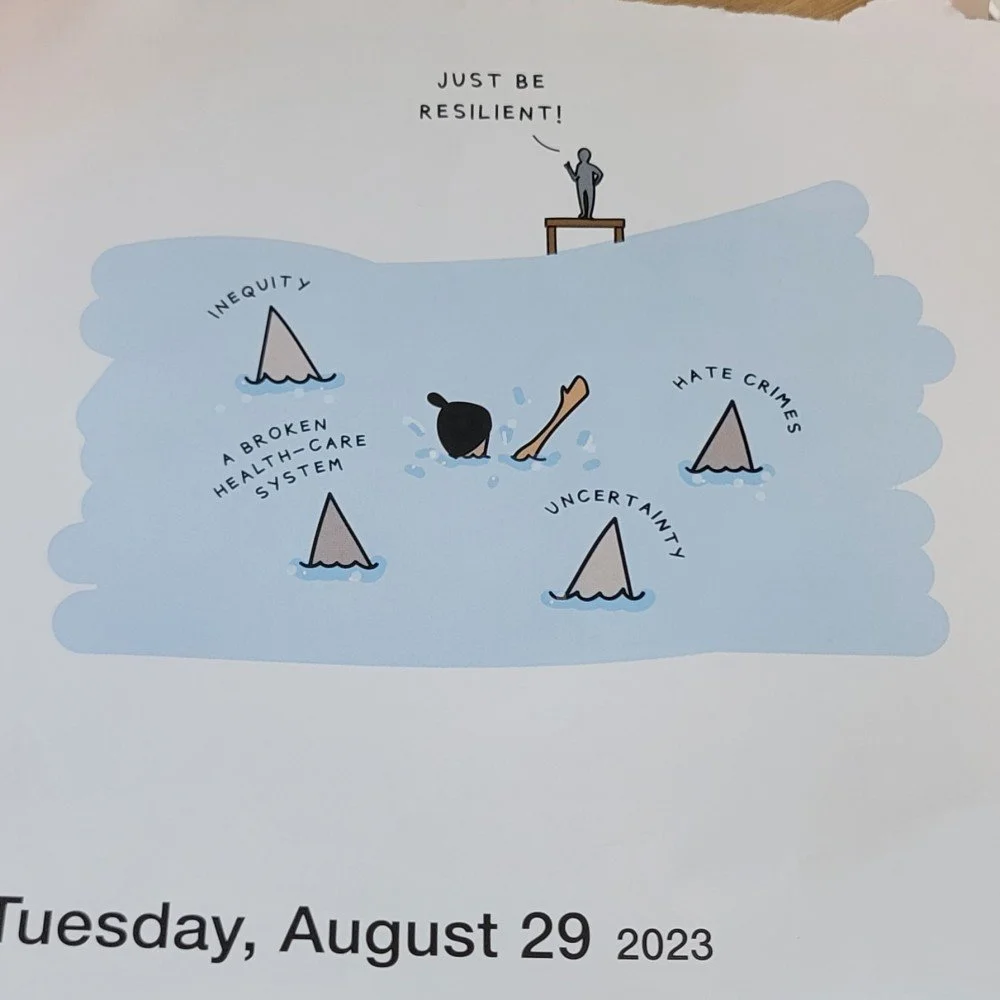Workplace Well-Being is MORE than a benefit
How are you feeling these days? Do you notice any undercurrents of weariness? Brain fog? Irritation or impatience? Overwhelm? Numbness?
If you’re a people or organizational leader, how are your employees feeling? Have you asked them? Do they feel safe enough to be honest? Or do you know they are experiencing some of the same signs and symptoms of stress and burnout… but you don’t know what to do about it?
If you and all of your employees are feeling super charged and energetic and just loving work and life, then maybe you can skip this newsletter as it may not be for you. But if you know exactly what I’m talking about and are wondering where the light is at the end of this tunnel, then read on. Because I’m here to talk about the very REAL issue of stress and burnout and what to DO about it.
In this edition, I will cover three things - the Reality, the Wrong Response and the Right Response.
The Perfect Storm
First of all - you are NOT alone.
According to recent research released by Gallup, more than 60% of global workers are struggling or suffering, and the percentage of employees who say they feel stress, worry and sadness a lot of the day or who feel burned out at work very often or always, have increased in the past decade. Meanwhile, the belief that our organization cares about us, which was on the rise up through 2019 and peaked sharply at the start of the COVID pandemic, has steadily decreased since 2020 to levels we’d not seen in a decade.
The fact of the matter is that the accumulated amount of global, chronic stress - caused by COVID, social unrest, economic instability, political polarization, war and violence - combined with our own personal/acute life stressors in relationships and health and work - have created a “perfect storm” of sorts for the human brain. Put simply - we were NOT made to handle this amount of long term stress - and it shows. Seemingly small things that didn’t used to bother us now may cause us to melt down.
This is the reality.
Don’t put bandaids on bleeding arteries
Many organizations are responding to our global mental health crisis and workplace burnout by increasing their well-being budget and adding perks like onsite mental health professionals, resilience workshops, quiet rooms, even mindfulness practices such as yoga or meditation. While I would never discourage any of these helpful and important benefits, they don’t address or solve the root problem.
In fact, companies who invest in these benefits while ignoring the ways that their organizational structure, policies, procedures and processes are contributing to stress in their employees’ lives, are coming across as tone deaf and indifferent, as this image by the brilliant Liz and Mollie represents.
Your employees are carrying the weight of external stress into the workplace every day. They can’t just put it down when they log in. Ignoring those stressors is a missed opportunity. But ADDING to those stressors with unrealistic workload, insensitive time off policies, lack of workplace flexibility, shaming performance management procedures and de-humanizing meetings… well… that’s a moral and organizational failure. One which you will pay for in lost ideas, lost productivity, and ultimately lost employees. Well-being as a “benefit” is the wrong response. Something more has to change.
Think like a farmer
This photo was re-shared recently on LinkedIn by my peer Gopal Sighn and when I saw it I said a hearty AMEN! I loved every point in the article and took the time to track down the source, which you can read more about by clicking on the image. I’ve seen similar memes using plants as an analogy for employees with the acknowledgement that when plants are dying you don’t blame the plant, you address the conditions the plant is in. It’s why I chose the word “Regenerative” to name my business (read more at my website here). So why aren’t we applying this horticultural approach to organizational environments more often?
Now don’t get me wrong - people aren’t plants. They do have some autonomy and the ability to leave their own poor conditions or to feed themselves if they are hungry or thirsty, but I hope you get the point. Yelling at a plant or “performance managing” a plant that is wilted and dry is a foolish waste of time. Don’t our employees deserve at least an assessment of their conditions before blaming them for poor performance, disengagement? Or would we rather they walk out the doors on their own?
The World Health Organization (WHO) includes “psycho-social stress and mental health” among their list of occupational hazards and defines burnout in the ICD-11 as “a syndrome conceptualized as resulting from chronic workplace stress that has not been successfully managed.” Which begs the question… managed by whom? Who is managing workplace stress? Are you? Is your senior leadership team? Do you know where to start? The WHO provides a short list of suggestions in this infographic, but I would challenge you to dig even deeper.
It’s time for organizations to get strategic rather than tactical when it comes to workplace well-being. The right response requires systemic thinking - stepping back from fighting symptoms and taking the time and care to understand and address root causes.
My next newsletter edition will begin to break down some of the systemic causes of workplace stress as well as some solutions to consider. But why wait? Reach out to me personally to schedule a discovery session to find out if a little bit of time with an organization health and well-being expert could put your company on the right path towards systemic, holistic workplace well-being strategy!




